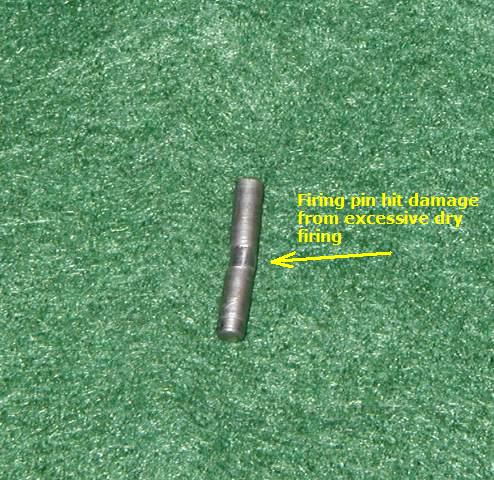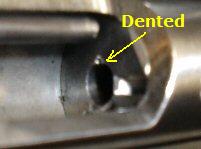Does anyone know the straight info on whether a Ruger Mark III is safe to dryfire? I've always been reluctant to dry fire a rimfire rifle or pistol for fear of damaging a firing pin. But I seem to remember reading somewhere that the Ruger Marks have a firing pin stop that prevents the firing pin from slamming into the breech face if there is nothing in the chamber. This would seem to mean I could dry fire to my heart's content without damaging the firing pin. True or false?
DWS
Dry Firing
Moderators: Bullseye, Moderators
-
DancesWithSquirrels
- Regular contributor

- Posts: 107
- Joined: Wed Aug 17, 2005 7:36 am
- Location: New Jersey
Mark IIs and Mark IIIs have the identical firing pin stop parts. Dry firing is deemed OK in the Ruger owners manual. You won't have any trouble dry firing your pistol. However, that doesn't mean that the pin stop cannot get over stressed and fail from excessive dry firing. I had a pin stop stress crack and fail once, but that was after about 50K worth of dry firing. You should be fine.
R,
Bullseye
R,
Bullseye

-
DancesWithSquirrels
- Regular contributor

- Posts: 107
- Joined: Wed Aug 17, 2005 7:36 am
- Location: New Jersey
TX
Thanks Bullseye,
I knew you had to dry fire to break them down but I didn't remember reading in the manual that it was OK for regular dry fire practice. Next time I have the manual out I'll have to look for it. I don't know if I'll dry fire 50K worth but any regular practice will put more stress on the parts than just dropping the hammer for take down purposes.
DWS
I knew you had to dry fire to break them down but I didn't remember reading in the manual that it was OK for regular dry fire practice. Next time I have the manual out I'll have to look for it. I don't know if I'll dry fire 50K worth but any regular practice will put more stress on the parts than just dropping the hammer for take down purposes.
DWS
Dryfire with .22 Rimfire
Thjis is literally a sore spot with me. My dad gave me a beautiful bolt action .22 in in about 1950. Slim, slick action, pointed like my finger, the only rifle with which I ever made a killing shot on a running rabbit. On squirrels it was deadly. It was a Savage, or Remington, or Winchester I really don't remember. Tubular fed, two hefty blocks elevated the cartidges for insertin into the chamber. At any rate I dry fired the daylights out of it in anticipation of going hunting and the firing pin broke. This was at the end of the Depression and getting a replacement was futile. I had reduced a reliable rabbit/squirell cooking pot filler into a useless stick. My Dad whomped me enough times to make the memory indelible. I suspect that little rifle allowed contact between the firing pin and the breech face ultimately failing the pin. I don't see marks from any such contact on my MKII . My conclusion is is that the 20 minutes a day of dryfire with my MK II shouldn't hurt a thing.
Misfire
There is a stop pin in a Mark series pistol that prevents the firing pin from contacting the chamber mouth. However this pin takes a lot of stress from excessive dry firing and can wear or break. It is a good idea to check it periodically for signs of stress before it breaks. Here's what one looks like that has deformed just enough to allow the pin to contact the breech face.

If during a routine cleaning you see a mark on the chamber face like this one, your firing pin stop has failed. A chamber iron may be needed to repair the damage if the dent is deep enough to cause feeding problems.

Periocally inspecting the firing pin is another good idea. I have seen a few cases of the pin tips breaking off and fracturing from stretching.
Routine dry firing typically will not damage these components but excessive usage can cause the parts to wear out.
Hope this helps.
R,
Bullseye

If during a routine cleaning you see a mark on the chamber face like this one, your firing pin stop has failed. A chamber iron may be needed to repair the damage if the dent is deep enough to cause feeding problems.

Periocally inspecting the firing pin is another good idea. I have seen a few cases of the pin tips breaking off and fracturing from stretching.
Routine dry firing typically will not damage these components but excessive usage can cause the parts to wear out.
Hope this helps.
R,
Bullseye

Dry Firing Mark II
My son's 22 auto had a dinged chamber mouth from dry firing too much. He had problems extracting from it untill fixed.


